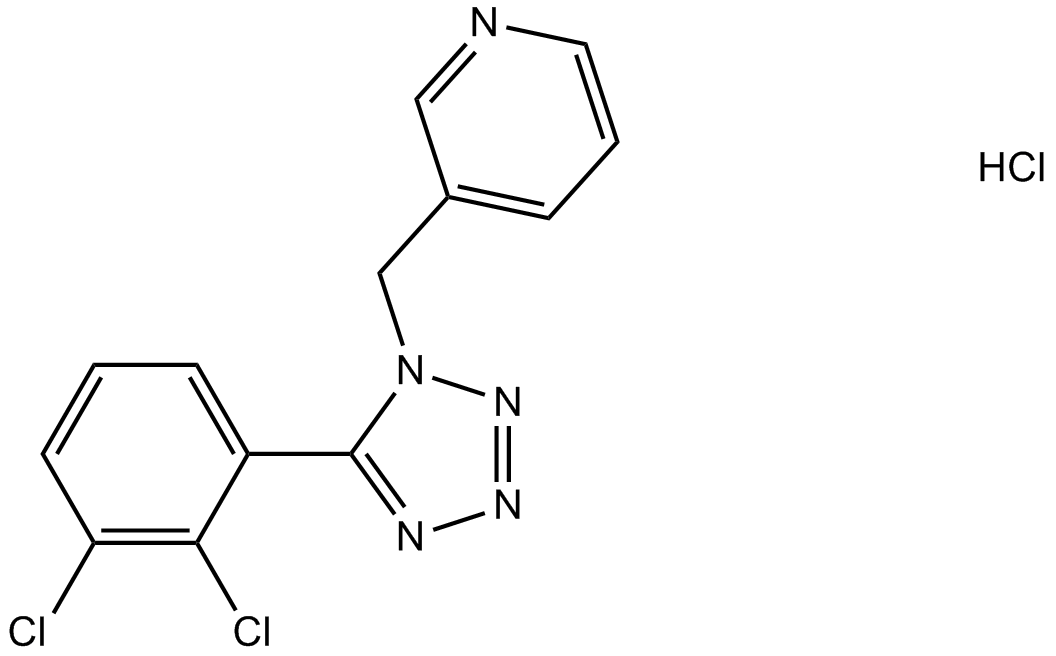A 438079 |
| Catalog No.GC17212 |
An antagonist of the nucleotide receptor P2X7
Products are for research use only. Not for human use. We do not sell to patients.

Cas No.: 899507-36-9
Sample solution is provided at 25 µL, 10mM.
A438079 is a selective small-molecule antagonist of human P2X7 receptor with IC50 value of 300 nM [1].
The nucleotide receptor P2X7 receptor is a subtype of the P2X receptor family. It is expressed in cells of both the central nervous system and the immune system. Since the activation of P2X7 receptor by ATP is associated with the release of glutamate and cytokines, P2X7 receptor is thought to be a target of the treatment for inflammation and neurodegeneration. The tetrazole-based compound A438079 works as a competitive antagonist of P2X7 receptor and shows potent antinociceptive activity in rat model [2].
A 438079 was selective against P2X7 receptor and showed no significant activity against other P2X receptors including P2X2, P2X3 and P2X4 even at concentration up to 10 μM. For other cell-surface ion channels and receptors, A 438079 also showed no effect. In the FLIPR assay using human 1321N1 astrocytoma cells stably transfected with recombinant rat or human P2X7 receptors, pretreatment of A 438079 potently inhibited the calcium influx with IC50 values of 100 and 300 nM, respectively. In human THP-1 cells differentiated with IFNγ and LPS, A 438079 treatment inhibited interleukin-1β release stimulated by BzATP with pIC50 value of 6.7.Besides that, A 438079 was found to block the pore formation in humanTHP-1 cells [1 and 2].
In the rat model of neuropathic pain, administration of A 438079dose-dependently reduced the mechanical allodynia with ED50 value of 76 μM/kg. In mice with status epilepticus, administration of A 438079 resulted in decreased total seizure power, amplitude and reduced seizure behavior. In addition, A 438079 was found to attenuate acetaminophen-induced liver injury in mice [2, 3 and 4].
References:
[1] Donnelly-Roberts DL, Jarvis MF. Discovery of P2X7 receptor-selective antagonists offers new insights into P2X7 receptor function and indicates a role in chronic pain states. Br J Pharmacol. 2007 Jul;151(5):571-9. Epub 2007 Apr 30.
[2] Nelson DW, Gregg RJ, Kort ME, Perez-Medrano A, Voight EA, Wang Y, Grayson G, Namovic MT, Donnelly-Roberts DL, Niforatos W, Honore P, Jarvis MF, Faltynek CR, Carroll WA. Structure-activity relationship studies on a series of novel, substituted 1-benzyl-5-phenyltetrazole P2X7 antagonists. J Med Chem. 2006 Jun 15;49(12):3659-66.
[3] Jimenez-Pacheco A, Mesuret G, Sanz-Rodriguez A, Tanaka K, Mooney C, Conroy R, Miras-Portugal MT, Diaz-Hernandez M, Henshall DC, Engel T. Increased neocortical expression of the P2X7 receptor after status epilepticus and anticonvulsant effect of P2X7 receptor antagonist A-438079. Epilepsia. 2013 Sep;54(9):1551-61.
[4] Xie Y, Williams CD, McGill MR, Lebofsky M, Ramachandran A, Jaeschke H. Purinergic receptor antagonist A438079 protects against acetaminophen-induced liver injury by inhibiting p450 isoenzymes, not by inflammasome activation. Toxicol Sci. 2013 Jan;131(1):325-35.
Average Rating: 5 (Based on Reviews and 30 reference(s) in Google Scholar.)
GLPBIO products are for RESEARCH USE ONLY. Please make sure your review or question is research based.
Required fields are marked with *




